
Wine Culture and Information since 2002 - Volume 22
 Wine Culture and Information since 2002 - Volume 22 |
|
Issue 241, Summer 2024 |
Contents |
|
|
The Italian Wine and the Market Challenges |
|
Good news regarding the Italian wine and its performance in foreign markets. Although it is small news, it is however good and, despite everything, evidently better than bad news, especially in these times. Wine – undeniably, as said over and over again – in recent years has certainly not shone in sales and, so to speak, has certainly experienced decidedly better times. The causes are many and well known to all, including the upheavals introduced during the recent Covid-19 pandemic, not least the consequent current economic and market conditions which have seen wine facing new scenarios. Among these, the well-known competition with beer, a drink that has always competed for the podium with wine, which, lately, seems to be more favored in consumer preferences. If this were not enough, in recent years competition has further increased as a result of the latest habits and fads associated to certain new drinks. The 2024 edition of the Annual Report Valoritalia – published in the recent past days – gives an image of the Italian wine which, between ups and downs, offers a glimpse of optimism for the future, with positive results, although of modest magnitude. The Valoritalia study examines the production and marketing of Italian wine in 2023, comparing it to 2022, as well as a preliminary investigation on the trend in 2024. In general terms, the volume of bottled wine produced by Italian wineries has increased of 0.54%, a result that achieves 2.8% more than the average of the previous three years. As mentioned, it is not a sensational result – definitely modest – but it however is a sign of recovery in light of the results of recent years. The performance of 2023, however, ended in a controversial way, as many of the aspects examined recorded decidedly negative results. One of these is the economic value of bottled wine, which has, on the contrary, decreased. In other words, more wine was bottled, but the profit was lower. Valoritalia's annual report analyzed data relating to 219 denominations of origin, which represent 56% of the Italian production of quality wines with over two billion bottles placed on the market. As regards production results, in 2023 the territory of North-West Italy saw its volume decrease by 8.3% compared to 2022, while the wineries of Central Italy recorded a decrease of 5.3%. The best result, in this sense, was achieved by the wineries of the North-East, with an increase of 3.7% compared to 2022, a result that was particularly achieved thanks to the growth in production of the Asolo DOCG and Veneto IGT denominations. As regards the trend of denominations – as had already emerged in other research – those belonging to the Indicazione Geografica Tipica (Typical Geographical Indication, IGT) category are driving the growth of Italian wines, which, alone, record an increase of 16.5% equivalent to over 97.6 million bottles. On the other hand, wines produced in the territories with Denominazione d'Origine Controllata (Denomination of Controlled Origin, DOC) recorded a decline of 2.8%, while those with Denominazione d'Origine Controllata e Garantita (Denomination of Controlled and Guaranteed Origin, DOCG) recorded a drop of 8%. The result of denomination wines, at the end of 2023, recorded an overall decrease of 1.3% compared to 2022. If 2023 showed a timid increase in the volume of bottled wine, 2024 instead gives hope for a much better result. In fact, in the first four months, the volume of bottled wine increased by 1.1%, therefore more than double the overall result achieved in 2023. Market challenges are, last but not least, also regulated by new trends as well as by the social and cultural changes of recent years, conditions that producers are forced to follow precisely with the aim of maintaining or gaining precious market shares. According to what emerges from a study by Nomisma-Wine Monitor and commissioned by Valoritalia, wine consumers seem to be particularly interested in issues related to sustainability and environmental protection, as well as respect for ethical and social values. This consumer orientation – in fact – has influenced the strategies and production policies of many wineries, so much so that 93% of Italian companies today consider sustainability a fundamental aspect for their development. After all, it is about the old but always valid, as well as indissoluble, link between supply and demand: consumers ask for greater sustainability, producers adapt, trying to offer what the market asks for and sells. In the same way, wineries – if they intend to maintain their market shares and conquer new ones – are offering consumers styles of wines which, both as a result of new trends and to counter the crisis of recent years, seem to attract greater interest from consumers. So they adapt their production, or start new and specific ranges, to what are the current trends and fads in terms of enology. In fact, fermentation and aging of wines in “new containers” are making their way which, until a few years ago, certainly did not enjoy the favor of the majority and which today have become, almost by magic, the new wine religion. In this regard, it is surprising to see how certain producers – who in the past were extremely critical of certain winemaking practices – are now convinced supporters of them. How times and ideas change, especially when you look at your not exactly good balance-sheet. It is certainly understandable that in these cases they must make a virtue out of necessity and, in some way, the wineries – which are first of all businesses – have the primary priority of producing a profit, even at the cost of denying their positions of the past and embrace new fads and what the market is demanding. Regardless of what the reasons are, the fact that Italian wine achieved positive results in terms of sales in 2023 and, even more so, in the first quarter of 2024, is good, very good news. Trusting that this result can be confirmed and improved during 2024, these are important signals that certainly point to a less uncertain future for Italian wine. Without forgetting – not least – that the producers of other countries also find themselves, more or less, in the same condition and they all compete in the same markets. At this moment, it seems, Italian wine is winning the market challenge, although with timid results, nevertheless encouraging and which are certainly welcome. At least to face the future, especially the next one, with greater optimism and confidence. Antonello Biancalana
|
||||
Contrasts of Umbria Chardonnay and Basilicata FianoThe queen of international grapes, found everywhere in the world, compared with one of the most important and representative white grapes of southern Italy. |
|
The Italian wine quality system, with which the origin of wines and production methods are certified, includes the Denominazione d'Origine Controllata e Garantita (Denomination of Controlled and Guaranteed Origin, DOCG) category at the highest level followed by the Denominazione d'Origine Controllata (Denomination of Controlled Origin, DOC). These two categories, as a result of the European regulations on this matter and implemented in Italy, fall into the community category “Denominazione d'Origine Protetta” (Protected Designation of Origin, PDO). The third category is represented by the territories with Indicazione Geografica Tipica (Typical Geographical Indication, IGT) which, as a consequence of the same European legislation, fall into the community category Indicazione Geografica Protetta (Protected Geographical Indication, PGI). This category defines rather large territories – definitely larger than the first two categories – allowing the production of wines according to less restrictive criteria, both in terms of composition of the grapes and production. The IGT category, although placed at the third level of the Italian quality system, is very often full of interesting surprises, not least of very high quality. Precisely because of the fewer production restrictions, this category is often used by producers for the classification of those wines which, despite being produced in the DOC and DOCG territories, are preferred to be included in the IGT category in order to have greater production and expressive freedom. In this regard, it must be noted that this category has been used by many producers in the past, even in a provocative and polemical way, in all those cases the production specifications of the higher categories turned out to be too restrictive, therefore limiting – as a matter of fact – their enological vision. This category is still widely used today by producers, with wines capable of expressing both high quality and an enological expression of absolute interest. The wines we examine in our tasting by contrast belong to this category. In fact, we will pour Umbria Chardonnay and Basilicata Fiano into our glasses, two decidedly distant grapes and produced in equally distant regions.
|
|
Chardonnay, undeniably the most famous international white berried grape, is found in almost every wine-growing area in the world, from the smallest to the largest one. Umbria is therefore no exception – the so-called green heart of Italy – the region located in the center of the country. In Umbria, in fact, Chardonnay is present in the composition of many wines, both with Denominazione d'Origine Controllata and Indicazione Geografica Tipica. The presence of the famous grape from Burgundy is prevalent in the wines of the latter category, used both alone and blended to other varieties, native and non-native ones. Chardonnay is being cultivated in Umbria since a very long time now, introduced into the region as a prodigious grape and capable of performing amazing enological miracles. The same happened, as is known, in practically all the other regions of Italy, together with Merlot, in the hope of replicating the success of French wines which many thought was solely thanks to these two grapes. The first significant results achieved by Chardonnay in Umbria were obtained thanks to the union with Grechetto, a native grape of this region, certainly among the primary representatives of Umbria's white berried grapes. A successful enological combination, subsequently taken up by many wineries in the region, making wines fermented and aged both with the exclusive use of inert containers and – more frequently – using casks and barriques. However, there are also excellent examples of Chardonnay vinified alone, which, in parallel with the examples of blending with other varieties, have been produced in the region for a long time. In Umbria, in fact, the production of wines in which Chardonnay is present – alone or blended to other varieties – is quite significant and the majority of these are registered in the Indicazione Geografica Tipica category. Winemaking is decidedly varied with producers using practically every type of container, from steel tanks to barriques.
|
||||
|
Fiano undeniably is one of the main and extraordinary white grapes of southern Italy and the whole country. Originally from Campania, a region in which it is capable of producing wines of notable and very high quality, Fiano is also present in other regions of Italy and not only in those in the south areas of the country. This variety is in fact present, although in marginal quantities, also in some regions of Central Italy, in the majority of cases used in combination with other grapes. In the regions of southern Italy, however, it is found almost everywhere and is used both for the production of mono-varietal wines and in combination with other varieties. Fiano is always and in any case capable of creating wines of notable qualitative value, with results of extraordinary personality, even outside Campania, its land of origin. In this regard, it must be noted that in Campania Fiano is the protagonist of many DOC and DOCG wines, including IGT ones. Basilicata owes its enological fame to Aglianico, the magnificent red grape that undoubtedly distinguishes many red wines from southern Italy. In the vineyards of this region, no less, there are many white grape varieties and, among these, we also find Fiano. In this region, Fiano is mainly used for white wines classified as Indicazione Geografica Tipica, mainly used alone. In this regard, it should be noted that the white wines of the Denominazione d'Origine Controllata Matera could use Fiano as a complementary quota to the Malvasia Bianca di Basilicata grape, for a maximum of 15%, as it is a non-aromatic grape suitable for cultivation in Basilicata. Thanks also to the fewer restrictions of the IGT category, Fiano in Basilicata is interpreted by producers with rather varied enological expressions, from aging in steel tanks to barrique, as well as made into sparkling wine through refermentation in the bottle, therefore with the classic method.
|
Let's find the two bottles that we will pour into the glasses for our tasting by contrast. The availability of these two wines is generally good and it will certainly be possible to purchase the two bottles in any specialized wine shop. As these are, in both cases, wines belonging to the Indicazione Geografica Tipica category – which allows greater production freedom compared to the higher categories – we will pay attention to the composition of the two wines. Both Umbria Chardonnay and Basilicata Fiano must be produced with their respective grapes alone, therefore without the addition of other varieties. As regards the enological and production aspects, our choice is in favor – for both bottles – of two wines fermented and aged in steel tanks. We will also choose wines belonging to the latest available vintage and they will be poured into the respective tasting glasses at a temperature of 10 °C. (50 °F). We can finally pour Umbria Chardonnay and Basilicata Fiano into our glasses and begin the tasting by contrast. The first sensorial evaluation we will carry out is, as usual, related to the appearance of the wines, that is color and transparency. Let's proceed with the examination of Umbria Chardonnay and, by tilting the glass over a white surface, for example, a sheet of paper, observe the base. The color of this wine is intense and brilliant straw yellow, while the nuance – observed at the edge of the opening of the glass, where the thickness of the wine is minimal – shows the same base color, often with a greenish yellow. Transparency, evaluated by placing a contrasting object between the glass and the white surface, appears to be very high. Let's move on to the evaluation of Basilicata Fiano and, still tilting the glass over the white surface, at the base we observe an intense straw yellow color, often darker than Umbria Chardonnay. The nuance of the Lucanian wine confirms the base color and, as in the previous wine, the transparency is very high. The olfactory profiles of Chardonnay and Fiano are characterized by evident differences and, in this sense, their wines are easily recognizable, especially in a direct comparison as in our case. Chardonnay, regardless of the place where it was grown, can be recognized for its aromas of acacia, banana and pear, often with sensations of citrus fruits and exotic fruit. The wines produced with this grape in Umbria – of course – are no exception. Furthermore, the production technique plays an important role in the composition of its aromas and, because of the frequent use of the fermentation and aging in barrels, in Chardonnay wines can be perceived sensations reminiscent of vanilla, as well as butter, praline and croissant. Moreover, they are also characterized by aromas that directly recall apple, peach and pineapple, as well as other sensations that can be associated to exotic fruit. The profile expressed by the wines produced with Fiano is very different, including those from Basilicata. On the nose they express aromas of apple, pear and pineapple, as well as floral sensations in which hawthorn and broom can be recognized. Furthermore, very often in wines produced with Fiano the aromas of hazelnut and citrus fruits are perceived, as well as linden, peach and honey. Let's resume our tasting by contrast and proceed with the analysis of the olfactory profiles of the two wines, starting – as in the previous phase – from the Umbria Chardonnay. Let's hold the glass in vertical position and, without swirling, proceed with the first smell in order to evaluate the opening, that is, the primary and identifying olfactory qualities. From the glass we can appreciate intense and clean aromas of banana, pear and acacia, an opening that is typical of Chardonnay wines. After having swirled the glass, an operation which favors the development of other aromas, let's proceed with the second smell. The olfactory profile of Umbria Chardonnay is completed with apple, peach, pineapple, lychee and grapefruit. Let's now move on to the olfactory examination of Basilicata Fiano and, after the first smell, we evaluate its opening. From the glass can be perceived intense and clean aromas of apple, pear and pineapple followed by hawthorn. After having swirled the glass and did the second smell, the profile of the wine is completed with broom, peach, citrus fruits, linden and a mineral sensation. Let's now move on to evaluating the gustatory profiles of our wines, starting again with Umbria Chardonnay. Let's take a sip of the Umbrian wine in order to evaluate its attack, that is, the initial and identifying sensations perceived in the mouth. At the first sip it can be immediately appreciated the crispness given by the acidity followed by a pleasing sensation of roundness, the latter characteristic being very frequent in wines produced with Chardonnay. The effect of alcohol further contributes to rounding the wine, while still managing to maintain a perfect balance. In the mouth can also be perceived the flavors of banana, pear, apple and peach, as well as the sensation of structure which can be defined as “medium”. Let's now move on to the evaluation of the attack of Basilicata Fiano and take a sip of this wine. In the mouth can be immediately perceived the crispness given by the acidity – generally more intense than Chardonnay – and the sensation of roundness is decidedly lower than the Umbrian wine, despite the contribution, in this sense, of alcohol. In the mouth can be perceived the flavors of apple, pear, pineapple and hazelnut with a sensation of structure generally fuller than Umbria Chardonnay. We have reached the final phase of our tasting by contrast, so we can proceed with the examination of the final sensations that the two wines leave in the mouth after swallowing, in particular the taste-olfactory persistence, among the primary quality factors of a wine. The finish of Umbria Chardonnay is persistent and the flavors of banana, pear, apple and peach are clearly perceived in the mouth, with a pleasing sensation of acidity well balanced by a good roundness. The finish of Basilicata Fiano is equally persistent, leaving in the mouth intense flavors of apple, pear, pineapple and a pleasing sensation of crispness given by the acidity, as well as a hint of hazelnut. Moreover, the sensation of structure is fuller than in Chardonnay. Let's now place the two glasses next to each other and proceed with the final smell, first the Umbria Chardonnay and then the Basilicata Fiano: the olfactory differences are further and clearly evident.
|
||||||||
Wines of the Month |
|
|
|
Score legend Prices are to be considered as indicative. Prices may vary according to the country or the shop where wines are bought |
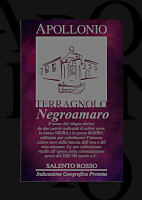
|
|
Terragnolo Negroamaro 2018 |
|
| Apollonio (Apulia, Italy) | |
 Negroamaro Negroamaro | |
| Price: € 24.00 | Score: |
 Intense ruby red and nuances of garnet red, little transparency. Intense ruby red and nuances of garnet red, little transparency. Intense, clean, pleasing, refined and elegant, starts with hints of
plum, blackberry and dried violet followed by aromas of black cherry,
blueberry, black currant, carob, cocoa, tobacco, licorice, mace, leather,
vanilla and menthol. Intense, clean, pleasing, refined and elegant, starts with hints of
plum, blackberry and dried violet followed by aromas of black cherry,
blueberry, black currant, carob, cocoa, tobacco, licorice, mace, leather,
vanilla and menthol.
 Properly tannic attack and however balanced by alcohol, good body,
intense flavors, pleasing roundness. Properly tannic attack and however balanced by alcohol, good body,
intense flavors, pleasing roundness.
 Persistent finish with flavors of plum, blackberry and black cherry. Persistent finish with flavors of plum, blackberry and black cherry. 12 months in barrique, 6 months in cask, 6 months in bottle. 12 months in barrique, 6 months in cask, 6 months in bottle. |
|
 Broiled meat and barbecue, Roasted meat, Stewed meat with mushrooms, Hard cheese Broiled meat and barbecue, Roasted meat, Stewed meat with mushrooms, Hard cheese |
|
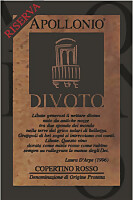
|
|
Copertino Rosso Riserva Divoto 2013 |
|
| Apollonio (Apulia, Italy) | |
 Negroamaro (70%), Montepulciano (30%) Negroamaro (70%), Montepulciano (30%) | |
| Price: € 35.00 | Score: |
 Deep ruby red and nuances of garnet red, little transparency. Deep ruby red and nuances of garnet red, little transparency. Intense, clean, pleasing, refined and elegant, starts with hints of
prune, black cherry jam and dried violet followed by aromas of blackberry
jam, blueberry jam, carob, tobacco, cocoa, coffee, licorice, cardamom,
leather, vanilla and menthol. Intense, clean, pleasing, refined and elegant, starts with hints of
prune, black cherry jam and dried violet followed by aromas of blackberry
jam, blueberry jam, carob, tobacco, cocoa, coffee, licorice, cardamom,
leather, vanilla and menthol.
 Properly tannic attack and however balanced by alcohol, good body,
intense flavors, pleasing roundness. Properly tannic attack and however balanced by alcohol, good body,
intense flavors, pleasing roundness.
 Persistent finish with flavors of prune, black cherry jam and
blackberry jam. Persistent finish with flavors of prune, black cherry jam and
blackberry jam.
 24 months in barrique, 6 months in cask, 12 months in bottle. 24 months in barrique, 6 months in cask, 12 months in bottle. |
|
 Broiled meat and barbecue, Roasted meat, Stewed and braised meat with mushrooms, Hard cheese Broiled meat and barbecue, Roasted meat, Stewed and braised meat with mushrooms, Hard cheese |
|

|
|
Latinia 2019 |
|
| Santadi (Sardinia, Italy) | |
 Nasco Nasco | |
| Price: € 21.00 - 375 ml | Score: |
 Intense amber yellow and nuances of amber yellow, moderate
transparency. Intense amber yellow and nuances of amber yellow, moderate
transparency.
 Intense, clean, pleasing, refined and elegant, starts with hints of
raisin, dried fig and apricot jam followed by aromas of peach jam, quince
jam, date, citrus fruit peel, lychee, candied fruits, honey, caramel,
lavender, walnut, tamarind, vanilla and nail polish. Intense, clean, pleasing, refined and elegant, starts with hints of
raisin, dried fig and apricot jam followed by aromas of peach jam, quince
jam, date, citrus fruit peel, lychee, candied fruits, honey, caramel,
lavender, walnut, tamarind, vanilla and nail polish.
 Sweet and round attack, however balanced by alcohol, good body, intense
flavors, pleasing crispness. Sweet and round attack, however balanced by alcohol, good body, intense
flavors, pleasing crispness.
 Persistent finish with flavors of raisin, dried fig and honey. Persistent finish with flavors of raisin, dried fig and honey. Few months in barrique. Few months in barrique. |
|
 Dried fruit and jam tarts, Hard and piquant cheese Dried fruit and jam tarts, Hard and piquant cheese |
|
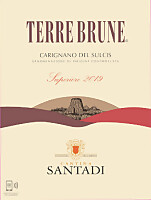
|
|
Carignano del Sulcis Rosso Superiore Terre Brune 2019 |
|
| Santadi (Sardinia, Italy) | |
 Carignano, Bovale Carignano, Bovale | |
| Price: € 43.00 | Score: |
 Intense ruby red and nuances of garnet red, little transparency. Intense ruby red and nuances of garnet red, little transparency. Intense, clean, pleasing, refined and elegant, starts with hints of
plum, black cherry and blueberry followed by aromas of dried violet, iris,
blackberry, carob, cocoa, tobacco, tar, mace, licorice, leather, vanilla
and menthol. Intense, clean, pleasing, refined and elegant, starts with hints of
plum, black cherry and blueberry followed by aromas of dried violet, iris,
blackberry, carob, cocoa, tobacco, tar, mace, licorice, leather, vanilla
and menthol.
 Properly tannic attack and however balanced by alcohol, good body,
intense flavors, agreeable. Properly tannic attack and however balanced by alcohol, good body,
intense flavors, agreeable.
 Very persistent finish with long flavors of plum, black cherry and
blueberry. Very persistent finish with long flavors of plum, black cherry and
blueberry.
 18 months in barrique, 12 months in bottle. 18 months in barrique, 12 months in bottle. |
|
 Roasted meat, Broiled meat and barbecue, Stewed and braised meat with mushrooms, Hard cheese Roasted meat, Broiled meat and barbecue, Stewed and braised meat with mushrooms, Hard cheese |
|
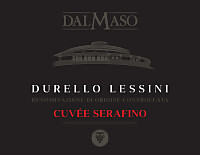
|
|
Lessini Durello Metodo Classico Pas Dosé Cuvée Serafino 2016 |
|
| Dal Maso (Veneto, Italy) | |
 Durella Durella | |
| Price: € 40.00 | Score: |
 Brilliant straw yellow and nuances of straw yellow, very transparent,
fine and persistent perlage. Brilliant straw yellow and nuances of straw yellow, very transparent,
fine and persistent perlage.
 Intense, clean, pleasing, refined and elegant, starts with hints of
apple, pera and bread crust followed by aromas of broom, hawthorn,
grapefruit, citron, plum, medlar, hazelnut, honey, praline, butter and
croissant. Intense, clean, pleasing, refined and elegant, starts with hints of
apple, pera and bread crust followed by aromas of broom, hawthorn,
grapefruit, citron, plum, medlar, hazelnut, honey, praline, butter and
croissant.
 Effervescent and crisp attack, however balanced by alcohol, good body,
intense flavors, agreeable. Effervescent and crisp attack, however balanced by alcohol, good body,
intense flavors, agreeable.
 Persistent finish with flavors of apple, pear and grapefruit. Persistent finish with flavors of apple, pear and grapefruit. Refermented in bottle and aged on its lees for 80 months. Refermented in bottle and aged on its lees for 80 months. |
|
 Pasta and risotto with fish and crustaceans, Roasted fish, Stewed fish, Sauteed white meat, Vegetable flans Pasta and risotto with fish and crustaceans, Roasted fish, Stewed fish, Sauteed white meat, Vegetable flans |
|

|
|
Colli Berici Merlot 25° Anniversario 2020 |
|
| Dal Maso (Veneto, Italy) | |
 Merlot Merlot | |
| Price: € 60.00 | Score: |
 Deep ruby red and nuances of garnet red, little transparency. Deep ruby red and nuances of garnet red, little transparency. Intense, clean, pleasing, refined and elegant, starts with hints of
black currant, black cherry and violet followed by aromas of iris, plum,
blueberry, cocoa, tobacco, cigar box, licorice, face powder, leather,
vanilla and eucalyptus. Intense, clean, pleasing, refined and elegant, starts with hints of
black currant, black cherry and violet followed by aromas of iris, plum,
blueberry, cocoa, tobacco, cigar box, licorice, face powder, leather,
vanilla and eucalyptus.
 Properly tannic attack and however balanced by alcohol, full body,
intense flavors, pleasing roundness. Properly tannic attack and however balanced by alcohol, full body,
intense flavors, pleasing roundness.
 Persistent finish with flavors of black currant, black cherry and plum. Persistent finish with flavors of black currant, black cherry and plum. 18 months in barrique, about 10 months in bottle. 18 months in barrique, about 10 months in bottle. |
|
 Game, Roasted meat, Stewed and braised meat, Hard cheese Game, Roasted meat, Stewed and braised meat, Hard cheese |
|

|
|
Friuli Isonzo Bianco Lis 2018 |
|
| Lis Neris (Friuli-Venezia Giulia, Italy) | |
 Pinot Grigio, Chardonnay, Sauvignon Blanc Pinot Grigio, Chardonnay, Sauvignon Blanc | |
| Price: € 40.00 | Score: |
 Intense straw yellow and nuances of golden yellow, very transparent. Intense straw yellow and nuances of golden yellow, very transparent. Intense, clean, pleasing, refined and elegant, starts with hints of
apple, grapefruit and banana followed by aromas of hawthorn, elder flower,
box flower, papaya, plum, bell pepper, honey, hazelnut, rosemary, vanilla
and flint. Intense, clean, pleasing, refined and elegant, starts with hints of
apple, grapefruit and banana followed by aromas of hawthorn, elder flower,
box flower, papaya, plum, bell pepper, honey, hazelnut, rosemary, vanilla
and flint.
 Crisp attack and however balanced by alcohol, full body, intense
flavors, pleasing roundness. Crisp attack and however balanced by alcohol, full body, intense
flavors, pleasing roundness.
 Persistent finish with flavors of apple, grapefruit and banana. Persistent finish with flavors of apple, grapefruit and banana. 11 months in cask, 27 months in steel tanks and bottle. 11 months in cask, 27 months in steel tanks and bottle. |
|
 Stuffed pasta with fish and mushrooms, Roasted white meat, Roasted fish, Stewed white meat with mushrooms Stuffed pasta with fish and mushrooms, Roasted white meat, Roasted fish, Stewed white meat with mushrooms |
|
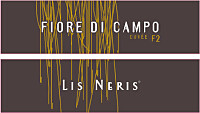
|
|
Friuli Isonzo Bianco Fiore di Campo Gold Cuvée F2 2019 |
|
| Lis Neris (Friuli-Venezia Giulia, Italy) | |
 Sauvignon Blanc, Friulano, Riesling Sauvignon Blanc, Friulano, Riesling | |
| Price: € 40.00 | Score: |
 Intense straw yellow and nuances of straw yellow, very transparent. Intense straw yellow and nuances of straw yellow, very transparent. Intense, clean, pleasing, refined and elegant, starts with hints of
gooseberry, bergamot and grapefruit followed by aromas of hawthorn, box
flower, broom, apple, lemon, pear, peach, pineapple, plum, nettle, green
bell pepper, almond and flint. Intense, clean, pleasing, refined and elegant, starts with hints of
gooseberry, bergamot and grapefruit followed by aromas of hawthorn, box
flower, broom, apple, lemon, pear, peach, pineapple, plum, nettle, green
bell pepper, almond and flint.
 Crisp attack and however balanced by alcohol, good body, intense
flavors, agreeable. Crisp attack and however balanced by alcohol, good body, intense
flavors, agreeable.
 Very persistent finish with long flavors of gooseberry, bergamot and
grapefruit. Very persistent finish with long flavors of gooseberry, bergamot and
grapefruit.
 22 months in steel tanks, 12 months in bottle. 22 months in steel tanks, 12 months in bottle. |
|
 Pasta with fish and crustaceans, Sauteed crustaceans, Stewed fish, Sauteed white meat, Dairy products Pasta with fish and crustaceans, Sauteed crustaceans, Stewed fish, Sauteed white meat, Dairy products |
|
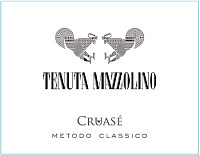
|
|
Oltrepò Pavese Metodo Classico Pinot Nero Rosé Cruasé 2019 |
|
| Tenuta Mazzolino (Lombardy, Italy) | |
 Pinot Nero Pinot Nero | |
| Price: € 33.00 | Score: |
 Brilliant cherry pink and nuances of cherry pink, transparent, fine and
persistent perlage. Brilliant cherry pink and nuances of cherry pink, transparent, fine and
persistent perlage.
 Intense, clean, pleasing and refined, starts with hints of cherry,
raspberry and strawberry followed by aromas of cyclamen, bread crust, pink
grapefruit, plum and tangerine. Intense, clean, pleasing and refined, starts with hints of cherry,
raspberry and strawberry followed by aromas of cyclamen, bread crust, pink
grapefruit, plum and tangerine.
 Effervescent and crisp attack, however balanced by alcohol, good body,
intense flavors, agreeable. Effervescent and crisp attack, however balanced by alcohol, good body,
intense flavors, agreeable.
 Persistent finish with flavors of cherry, raspberry and strawberry. Persistent finish with flavors of cherry, raspberry and strawberry. Refermented in bottle and aged on its lees for 40 months. Refermented in bottle and aged on its lees for 40 months. |
|
 Cold cuts, Fish and crustacean appetizers, Pasta with fish and crustaceans, Sauteed white meat, Broiled crustaceans, Dairy products Cold cuts, Fish and crustacean appetizers, Pasta with fish and crustaceans, Sauteed white meat, Broiled crustaceans, Dairy products |
|
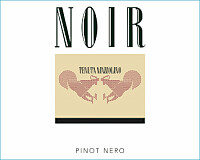
|
|
Pinot Nero dell'Oltrepò Pavese Noir 2020 |
|
| Tenuta Mazzolino (Lombardy, Italy) | |
 Pinot Nero Pinot Nero | |
| Price: € 38.00 | Score: |
 Brilliant ruby red and nuances of garnet red, moderate transparency. Brilliant ruby red and nuances of garnet red, moderate transparency. Intense, clean, pleasing, refined and elegant, starts with hints of
cherry, raspberry and dried rose followed by aromas of strawberry, plum,
chocolate, tobacco, licorice, leather, pink pepper, mace, vanilla and
menthol. Intense, clean, pleasing, refined and elegant, starts with hints of
cherry, raspberry and dried rose followed by aromas of strawberry, plum,
chocolate, tobacco, licorice, leather, pink pepper, mace, vanilla and
menthol.
 Properly tannic attack and however balanced by alcohol, good body,
intense flavors, pleasing crispness. Properly tannic attack and however balanced by alcohol, good body,
intense flavors, pleasing crispness.
 Persistent finish with flavors of cherry, raspberry and strawberry. Persistent finish with flavors of cherry, raspberry and strawberry. 12 months in Burgundian pièce. 12 months in Burgundian pièce. |
|
 Broiled meat and barbecue, Roasted meat, Stewed and braised meat with mushrooms, Hard cheese Broiled meat and barbecue, Roasted meat, Stewed and braised meat with mushrooms, Hard cheese |
|
News |
|
In this section are published news and information about events concerning the world of wine and food. Whoever is interested in publishing this kind of information can send us a mail to our address.
|
AquavitaeReview of Grappa, Distillates and Brand |
|
|
||||||||||||||||||||||||
Wine Guide ParadeApril 2024
|
| |||||||
Privacy Policy | |||||||


| Copyright © 2002-2024 Antonello Biancalana, DiWineTaste - All rights reserved |
| All rights reserved under international copyright conventions. No part of this publication and of this WEB site may be
reproduced or utilized in any form or by any means, electronic or mechanical, without permission in writing from DiWineTaste. |